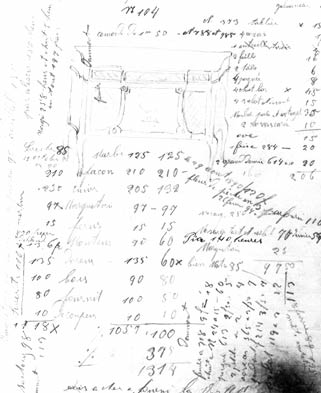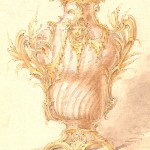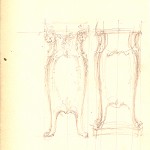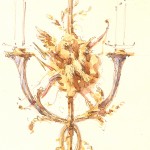The ‘Linke Archives’ are possibly a unique testimony to an internationally acclaimed cabinetmaker. Jean Bieder, Linke’s foreman or contremaitre in the 1920s, preserved the bulk of the Linke business archive. With no surviving sons, Linke had agreed for Bieder to purchase the business and its ‘fonds de commerce’. After Linke’s death in 1946, Bieder removed many of the precious documents to his home in Switzerland. It is not clear but it seems that a quantity of material had already been removed to avoid falling into the wrong hands during the German Occupation of Paris. With several tons of high quality bronze master patterns, it is indeed fortunate that this metal was not used to help furnish the war effort. Hearsay suggests that these master models were hidden in the basement of the workshops.
Further material has come from Linke’s own family, passed down through the eldest children. His daughter Caroline and granddaughter Geneviève, were thankfully great hoarders. Linke instilled into his daughter the importance of order and this was in turn passed to her own daughter, both revering the name of their illustrious father. Geneviève, widowed for the last thirty years of her life, guarded a mass of business and personal documents in her apartment on the Quai Henri IV. On her death they passed to her own grandchildren who do not carry the Linke name. It is hoped one day that a sample of this material can be put on public exhibition, an exhibition that would include, amongst other personal memorabilia, Linke’s office telephone, number ‘DID 06-51’.
Study Days at The Linke Archives
After an initial visit by curators from the Department of Furniture & Woodwork of the Victoria & Albert Museum, four separate groups visited the Linke Archive in London in March 2005. The first visit was by members of the Furniture History Society and it was very encouraging to receive so many applications. To get the best out of each visit, the maximum number of visitors was restricted to ten people, due to constrictions of space and to ensure that very visitor can participate and benefit from such unique information.
Each visit started in the workshop to see conservator Charles Engel working on a pair of bedside tables, index number 2569, by François Linke. These had been purchased in California and bought unseen. Unfortunately the condition report given by the auctioneers, although strictly speaking accurate, was misleading and somewhat uninformed. Yes the veneered surfaces were of a high gloss and unscratched and the gilding was a uniform colour. However the veneer had simply been coated in a thick polyurethane varnish. This is not the first time I have seen this as a ‘restoration’ technique used in the United States of America. It seems to have been and may still be in isolated workshops, a standard technique for shining up a faded wax finish. Although extremely laborious to remove it luckily does not normally harm the surface of the veneer. The polyurethane simply forms a protective and high gloss coating on the wood finish. This can be removed by taking the bronzes off and dry stripping the varnish. We normally use a custom-formed cow horn tool, fashioned from an old shoe horn, to chip off the varnish – somewhat like using one’s thumbnail!
In November 2006 the Linke Archive premises hosted the Annual General Meeting of the Furniture History Society followed by a well-attended day-long seminar. The Archives have now been moved and are not open to public view.
The Furniture History Society
Christopher Payne is a council member of The Furniture History Society. The Society has about 1600 members in the United Kingdom and throughout the world. Distinguished scholars in Britain and elsewhere are members of the Society and many of them contribute to the Society’s publications and become actively involved in its events.
The membership comprises numerous museums, libraries and other institutions as well as curators, conservators, lecturers, dealers, auctioneers, architects, designers, collectors and furniture enthusiasts. Members receive the regular publications of the Furniture History Society and are entitled to attend any of the various lectures or symposia held throughout the year and participate in special visits, study weekends or tours, subject to the availability of places.
To view the Society’s web site (which is in the process of being updated) or to inquire about membership, please click on the link below:

 Linke’s drawing & costings for his version of the commode delivered by Riesener to Versailles in 1776
Linke’s drawing & costings for his version of the commode delivered by Riesener to Versailles in 1776


 English
English